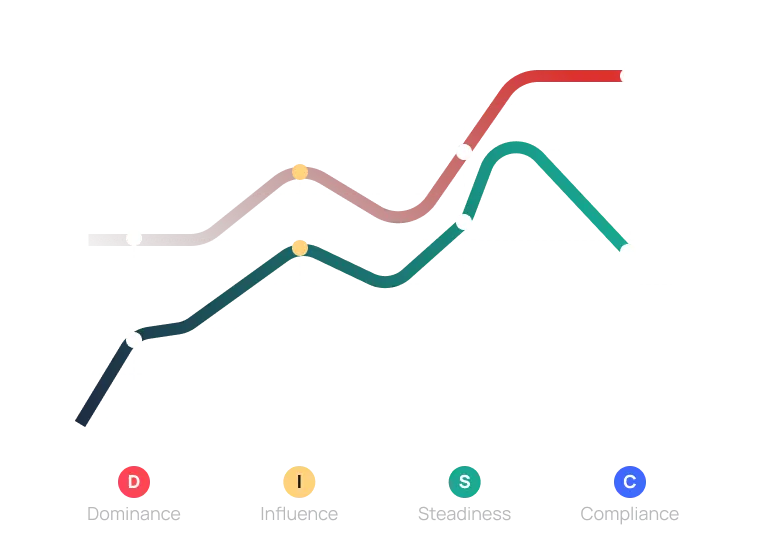Table of content
Left Brain vs Right Brain: Ways To Know Your Dominant Side
Left brain vs right brain: Which side leads your thinking? Discover your dominant side and how to use both for peak performance!
Table of content
Have you ever pondered the 'left brain vs. right brain' concept? What exactly does each hemisphere represent, and how can you discern your dominant brain side? Read on to figure out and know what can be more important than being left-brained or right-brained.
Origin Of Split-Brain Theory
The split brain theory became popular in the 1960s. Neuroscientist Roger Sperry, a Nobel Prize winner, studied how the left and right side of the brain work.
The neuropsychologist first tested the brain functions in animals to take a closer look into the differences between each brain side. During his experiment, Sperry studied the corpus callosum, a large bundle of neurons that connects the two hemispheres of the brain. By severing the corpus callosum in animals like cats or monkeys, Sperry found that two brain sides functioned independently of one another. This gave him first-hand data as to how different sides of the brain handled tasks.
Later on, he did a similar experiment on humans with their corpus callosum severed as treatment for epilepsy, a seizure disorder. He found the left brain often handles language, logic, and analysis. The right brain focuses on intuition, visuals, and creativity.
Though modern neuropsychology reveals that both brains work closely together, Sperry's theory has set a strong foundation for how people can utilize their minds for peak performance.
💡 Do you know: High IQ involves a combination of two-side of brain and both hemispheres of the brain contribute in various ways. Find out now!
How Do Left Brain And Right Brain Function?
Each side of the brain is responsible for certain tasks. So what are these tasks?
Left brain functions
Left brain is commonly known as the logical side of the brain, which governs:
- Language and Speech: Your left brain handles reading, writing, and speaking. It processes logic, analysis, and step-by-step thinking.
- Analysis and Math: This side of the brain prefers to process information in order. It's great for analytical tasks and math problems.
Right brain functions
Right brain tends to be the creative side of the brain, which controls:
- Intuition and Creativity: Your right brain manages creativity and seeing the big picture. It also helps with recognizing faces, understanding space, and processing non-verbal cues.
- Music and Art: The right brain is also strongly linked to music and art. It helps you understand complex sounds and emotions in music.
Left Brain Vs Right Brain: Differences
The left-brained and right-brained people process information in different ways. Not just that, each brain hemisphere also points to a person's natural strengths and areas of excellence.
This table below summarizes the main traits of each group. Reading the table can help you know which brain side is more dominant. You'll see differences in how you think, process information, and use skills like language, math, and emotions.
| Characteristics | Left brain | Right brain |
| Core thinking | Logic, analytical thinking | Intuitive, creative thinking |
| Information processing | Sequential, step-by-step information processing | Holistic, big-picture information processing |
| Language function | Language, sentence analysis, speaking, and writing | Understanding non-verbal cues, tone of voice, emotions |
| Problem-solving approach | Analytical, detailed, structured reasoning. | Intuitive, holistic, pattern recognition |
| Memory retrieval | Factual, specific, detail-oriented recall | Visual, experiential, associative recall |
| Decision-making style | Systematic, logical, evidence-based | Emotionally informed, intuitive, spontaneous |
In short, the left brain is more responsible for logic, data, and information while the right brain has to do with creativity, intuition and emotions.
How To Tell If You’re Left-Brained Or Right-Brained? Tips In 2025
So now you know two brain hemispheres’ functions, read on to define if you are left-brained or right-brained.

Here are some tips to test your brain in 2025, ask yourselves some following questions:
- Do you find yourself naturally good at remembering names and specific facts, or at recognizing faces and understanding moods?
- Do you prefer fiction or nonfiction books?
- Do you stick to plans, schedules or do you enjoy spontaneity, adaptability?
- Do you make most of your decisions based on logical facts or intuition?
- Are you more comfortable working with numbers and spreadsheets, or with colors, shapes, and designs?
- When you communicate, do you value precision and directness above all, or do you prioritize conveying nuance, emotion, and context?
If you consistently answer “yes” to the first part of these questions, you likely lean towards being left-brained. Otherwise, you are either more right-brained or have a balanced use of both hemispheres.
The questions above are only basic ones for you to know your dominant brain side. Check out our brain test for more accurate information.
Surprising Facts About The Left Side And Right Side Of Your Brain
Though understanding your brain functions is not rocket science, these upcoming facts can blow your mind. Check out to be surprised!
Left Brain - Right Hand vs Right Brain - Left Hand
Your left brain controls your right hand, and your right brain controls your left hand. This means left-handed people, governed by their right brain, tend to be more creative.
Studies show only about 10% of the population is left-handed. This unique group often displays higher creativity and intuition.
Your Brain Hemispheres Work Together Daily
Just like IQ, EQ, and AQ, your brain's left and right hemispheres work together. They connect via the corpus callosum, a "highway" for information flow.
"Left brain vs right brain hemispheres each handle different tasks, but they always work together," explains Dr. Tworek.
Researchers scanned over 1,000 brains, observing 7,000 unique regions in each person. Results showed that regardless of personality or hobbies, everyone uses both sides of their brain relatively equally.
In short, some people are more creative, others are better at analysis. But it's not because one half of the brain is stronger or used more. Instead, differences come from how both hemispheres cooperate to handle various tasks.
Tips To Balance Your Left Brain Vs Right Brain
Struggling with music or math? You can't blame one side of your brain for being weaker. So, what's the real key to getting better?
The answer is simple: Practice!
Get rid of limiting beliefs and mindsets
The labels we give ourselves can limit our growth. If you believe you're "left-brained," you might avoid creative activities. And if you think you're "artistic," you might shy away from logic or math.
The best solution? Engage both sides of your brain for daily tasks, fostering balanced left brain and right brain thinking. This helps you think smarter and adapt better.
Strengthen your right brain with creative activities
Don't just rely on your "stronger" brain side. Try new life skills to unlock your other hemisphere's potential!
For example, if you're great at analysis, try an art class like painting or singing lessons. Guided classes or workshops help you ease into creative activities and train your right brain.
Strengthen your left brain with organizing habits
If you struggle with organization, it doesn't mean you can't change. Creative people can learn to be more organized with practice. Use sticky notes to track tasks or set phone reminders for better time management.
Understand that your brain works like muscles
Some people have natural strengths in certain areas. But brains, like muscles, can be trained to get stronger. The more you practice and explore new things, the easier it is to develop new skills!
Brain Training With IQ, EQ Tests
IQ (Logical Intelligence) often links to your left brain. This side handles language and logical thinking skills. People with high IQs are often left-brained.
However, right-brained individuals also solve problems well with intuition and recognize relationships easily.
EQ (Emotional Intelligence) usually connects to your right brain. This side manages your emotions and how you process feelings. People with high EQs are often right-brained.
This shows in their ability to:
- Recognize and understand others' feelings.
- Show empathy and listen genuinely.
- Communicate beyond words, using emotions and body language.
- Resolve conflicts effectively and with finesse.
Developing a balanced brain helps you better understand both logical and emotional intelligence. This boosts your learning abilities and self-development.
Final Thoughts
This article has hopefully helped you answer what left brain and right brain mean. Both brain halves are key to how we think and work. Knowing the difference helps you understand your abilities. This lets you develop and balance them for peak performance in all things you do.
discpersonalities.com can help you boost both brain hemispheres' strengths with quality, trusted personality tests.
👉 Explore your brain's power now!
Frequently Asked Questions (FAQs)
1. Is the left brain or the right brain smarter?
Left brain vs right brain? No single brain hemisphere is "smarter" than the other. Each side focuses on different roles, like creativity or logic. Both hemispheres always work together to perform daily tasks and functions.
2. Which side of the brain rules languages and speech?
The left hemisphere governs your languages and speech.
3. Can I change my brain tendency?
Not exactly, but you can develop your other brain hemisphere's skills. Challenge yourself with unfamiliar activities.


Don't Let Your Potential Stay Hidden!
Take the DISC test today and discover your unique 'YOU', with deep insights into your true personality and potential.

Represents your instinctive behaviors and desires.
Shows the behavioral tendencies you think you should exhibit in specific situations.
Related articles
You may also be interested in
 Left Brain, Right BrainJul 17, 2025
Left Brain, Right BrainJul 17, 2025Top 9 Effective Brain Exercises To Train Your Mind Daily
Want to improve memory, boost focus, and spark creativity? These brain exercises are all it takes. Spend just 5 minutes daily to enhance your brain power.
 Left Brain, Right BrainJul 08, 2025
Left Brain, Right BrainJul 08, 2025Right-Brained Person: Key Strengths and Suitable Career Tips
Are you a right-brained person? Discover the 9 signs you're one and explore right-brained people’s careers. Scroll down to learn more!
 Left Brain, Right BrainJun 26, 2025
Left Brain, Right BrainJun 26, 2025Left-Brained Person: Strengths And Tips To Balance Both Sides Of The Brain
Are you a left-brained person? Discover the left brain's main functions and how to develop both brain sides for optimal mental performance in this article.
